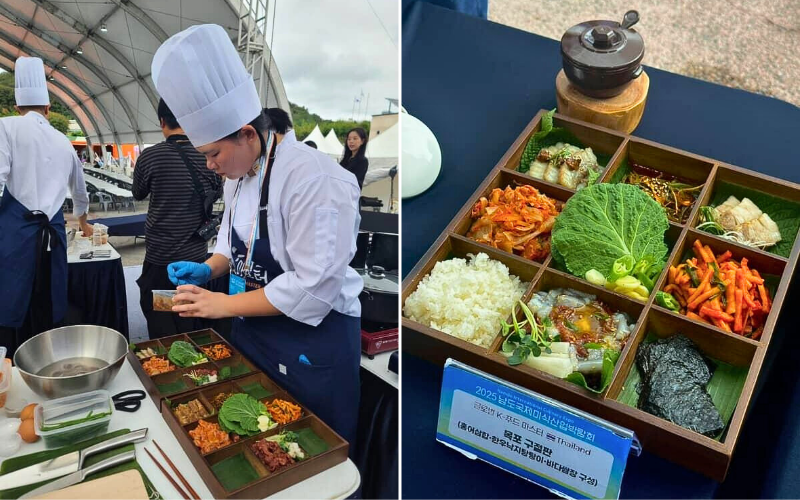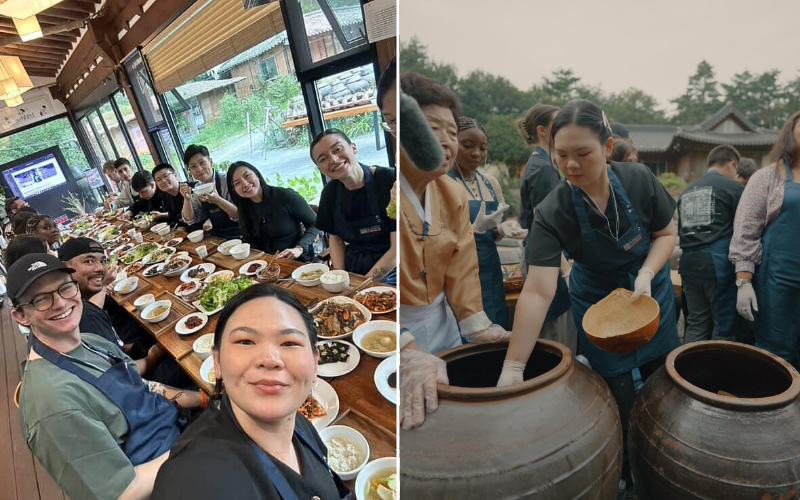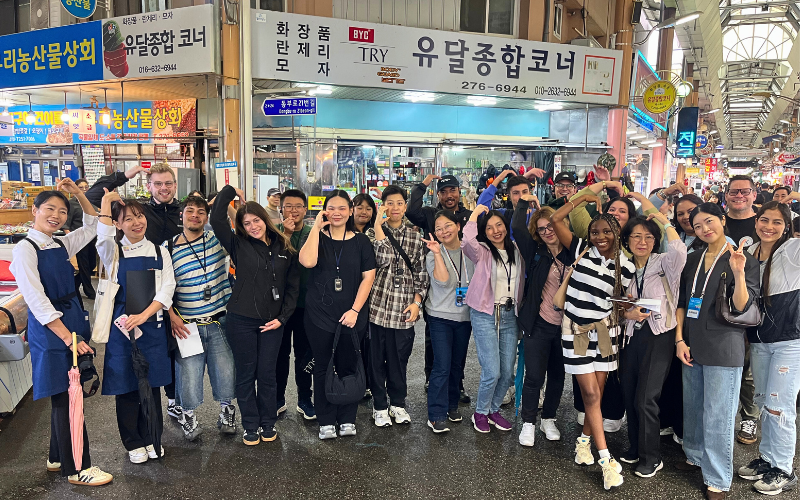[INTERVIEW] Thai chef claimed the K-Food Master Champion title at the 2025 Namdo International Culinary Expo
2025-10-26The 2025 Namdo International Culinary Expo (NICE), held in Mokpo, South Jeolla Province in Korea, celebrated the rich culinary heritage of the Namdo region and its vibrant food culture. Held from October 1 to 26 at the Mokpo Culture and Arts Center, Peace Plaza & Downtown Mokpo, the expo welcomed chefs, food lovers, and cultural ambassadors from across the globe.
Following their victories in the 2025 Hansik Contest, chefs from 13 countries including Hong Kong, Indonesia, Ireland, Spain, Turkey, the United States, Peru, Romania, Nigeria, Costa Rica, France, and Chile, competed in the Global K-Food Master Competition, a key event of the 2025 NICE. The chefs blended Namdo ingredients and traditional jang sauces with modern Korean cuisine, adding flavors and techniques from their homelands. While in Korea, they attended jang workshops and gained practical experience at the Namdo Culinary School, allowing them to explore Namdo cuisine up close.
Virun (Perth) Thananoptullathon, 28, from Thailand won the K-Food Master Champion title at the Global K-Food Master Competition, which took place on October 4. Perth has loved cooking since childhood, and she currently works as a cooking class instructor, teaching children at an international school in Bangkok, Thailand.
Below are excerpts from an email interview with Perth conducted on Oct 24-25, in which she discusses the 2025 Namdo International Culinary Expo in Mokpo and the dishes she prepared.
1. What was your first impression of the 2025 Namdo International Culinary Expo in Mokpo?
Mokpo is a small yet lovely city, and I really loved how beautifully they presented the Namdo International Culinary Expo there. My first impression began the moment I stepped into the exhibition. On the screen, I saw images of jars partly buried in the ground, with grass projected around them. When you looked inside the jars, you could see traditional Korean fermented foods. To me, it was a wonderful example of how culture and technology can come together, allowing the new generation to experience old traditions in modern and new ways. It was truly impressive.

2. Could you describe the combination of Thailand ingredients and Korean flavors that you presented?
First, I created a modern version of 홍어삼합 (hongeo samhap), a Korean dish with fermented skate, boiled pork and kimchi. Instead of using fermented skate, I used fresh skate marinated with Thai seasonings; garlic, pepper, and coriander root powder. These three ingredients are traditional Thai spices commonly used to marinate meat before grilling. I grilled the skate on Thai banana leaves, which are widely used in Thailand for their many benefits; as containers, for wrapping food, or even for decoration. By using banana leaves, I wanted to express a part of Thai culture while also solving a practical issue: the fish didn’t stick to the grill, so it worked like a natural non-stick pan.
Another Thai touch in my dish was the salted egg yolk I placed on top of my 고기낙지탕탕이 (gogi nakji tangtangi), a Korean-style raw beef and octopus tartare. Normally, this dish is topped with a fresh raw egg yolk, but I chose to marinate the yolk in Korean soy sauce, prepared in a Thai style. Across Asia, we have similar methods of marinating yolks, often enjoyed with rice or as a dipping side. However, I wanted to make my tangtangi special, blending the creaminess of the yolk with the rich flavor of Korean soy sauce, so I used this marinated version as the finishing touch on my dish.
3. Could you explain some of the dishes you created for the Global K-Food Master Competition?
The name of my winning dish was “목포구절판” (Mokpo Gujeolpan), inspired by the competition being held in Mokpo and my desire to showcase local ingredients. I wanted to highlight Jeolla-do cuisine, presented in a 구절판 (Gujeolpan), a plate divided into nine sections. To me, Gujeolpan represents one of the most beautiful and meaningful presentations in Korean cuisine, colorful and full of symbolism.
For my reinterpretation of 홍어삼합 (hongeo samhap), I used fresh skate marinated with Thai seasonings, grilled it on banana leaves, and topped it with Doenjang sauce. The pork belly was boiled in the traditional Doenjang style. I also created 고기낙지탕탕이 (gogi nakji tangtangi), combining Hanwoo beef and fresh baby octopus, mixed with Gochujang and other seasonings, and finished with salted egg yolk on top.The dish was served with a variety of accompaniments: kimchi, radish kimchi, a spring onion salad, seaweed, rice, lettuce, and my special Ssamjang, enriched with 갈치속젓 (Galchi-sokjeot), a fermented hairtail fish intestines sauce, and 새우젓 (Saeu-jeot), which is salted, fermented small shrimps.

4. What did you learn from the Korean master chefs during the fermentation workshops?
Before visiting Kisoondo in Damyang, I thought all Korean jang (fermented sauces) were the same, I had never realized the differences. There, I learned how to make it and experienced it in the traditional way, even tasting soy sauce straight from the jar. It allowed me to truly feel the depth of the culture and appreciate just how remarkable jang is. It was an incredibly impressive and memorable experience for me.
5. What do you think made your dish stand out and earn you the K-Food Master Champion title?
I believe my experience with Korean cuisine is quite extensive. My journey with Korean culture began when I was 13, sparked by a love for the Korean language. As I studied, my interest grew beyond the language, I developed a passion for Korean food and sought out many opportunities to experience it firsthand. This deep exposure has helped me understand the authentic flavors of Korean cuisine.
The dish I created was both new and innovative. I prepared extensively to learn more about Korea’s local cuisine before entering the competition. Although I had never been to Jeolla-do or tasted its regional specialties, I chose to cook Jeolla-do’s cuisine, particularly using skate fish. I consider this a bold decision, and by blending it with Thai flavors while presenting it in a traditional way, I was able to make the dish stand out.

6. What were some memorable moments from your time in Korea?
I met many wonderful people from around the world. For me, this competition wasn’t about competing against others; it was about challenging myself and presenting my ideas and best effort through my dish. I didn’t view the other participants as competitors, but as new friends. Meeting them and spending time together was the best moment.
7. What are your goals?
I have loved cooking since I was very young and have tried making many different kinds of food. Honestly, I wasn’t always sure what I could do best. However, after winning the K-Food Master Champion and learning so much from this experience, I realized that what I do best is what I have been passionate about all along. This has strengthened my desire to continue cooking Korean food and to keep learning more about Korean cuisine.
How about this article?
- Like1
- Support1
- Amazing0
- Sad0
- Curious0
- Insightful0


